Optimal Energy Management for Virtual Power Plant Considering Operation and Degradation Costs of Energy Storage System and Generators
Abstract
1. Introduction
- This paper introduces applying the VPP concept integration with minimizing the operation cost of generators and the degradation costs of the elements within the power system, especially the ESS and generators. Considering these degradation costs leads to the proper operation of the ESS and generators, which has not been studied combined with the VPP concept in the previous research works.
- Deploying the DE algorithm to achieve the optimal ESS scheduling in the energy management task considering the penetration of solar PV and EVCS is proposed. A simple structure, a few parameters for control, and excellent effectiveness and plausibility of the DE can guarantee that it is one of the most robust algorithms [27]. Additionally, to verify the performance of the proposed algorithm, the PSO algorithm, popularly used in VPP tasks [15,21,25], is utilized in this work to compare the solution with the proposed algorithm.
2. System Modeling
2.1. The VPP Model
2.2. The Solar PV Model
2.3. The EVCS Model
2.4. The ESS Model
3. Problem Formulation
3.1. The Objective Function
3.2. Constraints
4. The Proposed Optimal Energy Management of VPP based on the DE Algorithm
5. The Result and Discussion
5.1. System Description
5.1.1. Test System
5.1.2. Components of VPP
5.1.3. Simulation Program
5.2. The Effect of Solar PVs and EVCS on Power System
5.3. Optimal Energy Management of VPP Based on the DE Algorithm
6. Conclusions
Author Contributions
Funding
Data Availability Statement
Acknowledgments
Conflicts of Interest
References
- Department of Alternative Energy Development and Efficiency. Energy Efficiency Plan (EEP2018); Department of Alternative Energy Development and Efficiency: Bangkok, Thailand, 2018.
- Department of Alternative Energy Development and Efficiency. Alternative Energy Development Plan (AEDP2018); Department of Alternative Energy Development and Efficiency: Bangkok, Thailand, 2018.
- Aziz, S.; Wang, H.; Liu, Y.; Peng, J.; Jiang, H. Variable Universe Fuzzy Logic-Based Hybrid LFC Control With Real-Time Implementation. IEEE Access 2019, 7, 25535–25546. [Google Scholar] [CrossRef]
- Cheng, P.; Wang, H.; Stojanovic, V.; Liu, F.; He, S.; Shi, K. Dissipativity-based finite-time asynchronous output feedback control for wind turbine system via a hidden Markov model. Int. J. Syst. Sci. 2022, 53, 3177–3189. [Google Scholar] [CrossRef]
- Jiang, Y.; Gao, W.; Na, J.; Zhang, D.; Hämäläinen, T.T.; Stojanovic, V.; Lewis, F.L. Value Iteration and Adaptive Optimal Output Regulation with Assured Convergence Rate. Control. Eng. Pract. 2022, 121, 105042. [Google Scholar] [CrossRef]
- Aziz, S.; Peng, J.; Wang, H.; Jiang, H. ADMM-Based Distributed Optimization of Hybrid MTDC-AC Grid for Determining Smooth Operation Point. IEEE Access 2019, 7, 74238–74247. [Google Scholar] [CrossRef]
- Saboori, H.; Mohammadi, M.; Taghe, R. Virtual Power Plant (VPP), Definition, Concept, Components and Types. In Proceedings of the 2011 Asia-Pacific Power and Energy Engineering Conference, Wuhan, China, 25–28 March 2011; pp. 1–4. [Google Scholar]
- Narkhede, M.S.; Chatterji, S.; Ghosh, S. Optimal Dispatch of Renewable Energy Sources in Smart Grid Pertinent to Virtual Power Plant. In Proceedings of the 2013 International Conference on Green Computing, Communication and Conservation of Energy (ICGCE), Chennai, India, 12–14 December 2013; pp. 525–529. [Google Scholar]
- Zhang, R.; Li, G.; Bu, S.; Aziz, S.; Qureshi, R. Data-Driven Cooperative Trading Framework for a Risk-Constrained Wind Integrated Power System Considering Market Uncertainties. Int. J. Electr. Power Energy Syst. 2023, 144, 108566. [Google Scholar] [CrossRef]
- Othman, M.M.; Hegazy, Y.G.; Abdelaziz, A.Y. Electrical Energy Management in Unbalanced Distribution Networks Using Virtual Power Plant Concept. Electr. Power Syst. Res. 2017, 145, 157–165. [Google Scholar] [CrossRef]
- Kasaei, M.J.; Gandomkar, M.; Nikoukar, J. Optimal Management of Renewable Energy Sources by Virtual Power Plant. Renew. Energy 2017, 114, 1180–1188. [Google Scholar] [CrossRef]
- Naval, N.; Sánchez, R.; Yusta, J.M. A Virtual Power Plant Optimal Dispatch Model with Large and Small-Scale Distributed Renewable Generation. Renew. Energy 2020, 151, 57–69. [Google Scholar] [CrossRef]
- Wu, H.; Liu, X.; Ye, B.; Xu, B. Optimal Dispatch and Bidding Strategy of a Virtual Power Plant Based on a Stackelberg Game. IET Gener. Transm. Distrib. 2020, 14, 552–563. [Google Scholar] [CrossRef]
- Zhou, B.; Liu, X.; Cao, Y.; Li, C.; Chung, C.Y.; Chan, K.W. Optimal scheduling of virtual power plant with battery degradation cost. IET Gener. Transm. Distrib. 2016, 10, 712–725. [Google Scholar] [CrossRef]
- Hannan, M.A.; Abdolrasol, M.G.M.; Faisal, M.; Ker, P.J.; Begum, R.A.; Hussain, A. Binary Particle Swarm Optimization for Scheduling MG Integrated Virtual Power Plant Toward Energy Saving. IEEE Access 2019, 7, 107937–107951. [Google Scholar] [CrossRef]
- Yan, Q.; Zhang, M.; Lin, H.; Li, W. Two-Stage Adjustable Robust Optimal Dispatching Model for Multi-Energy Virtual Power Plant Considering Multiple Uncertainties and Carbon Trading. J. Clean. Prod. 2022, 336, 130400. [Google Scholar] [CrossRef]
- Shafiekhani, M.; Ahmadi, A.; Homaee, O.; Shafie-khah, M.; Catalão, J.P.S. Optimal Bidding Strategy of a Renewable-Based Virtual Power Plant Including Wind and Solar Units and Dispatchable Loads. Energy 2022, 239, 122379. [Google Scholar] [CrossRef]
- Sun, S.; Kazemi-Razi, S.M.; Kaigutha, L.G.; Marzband, M.; Nafisi, H.; Al-Sumaiti, A.S. Day-Ahead Offering Strategy in the Market for Concentrating Solar Power Considering Thermoelectric Decoupling by a Compressed Air Energy Storage. Appl. Energy 2022, 305, 117804. [Google Scholar] [CrossRef]
- Liu, Y.; Li, M.; Lian, H.; Tang, X.; Liu, C.; Jiang, C. Optimal Dispatch of Virtual Power Plant Using Interval and Deterministic Combined Optimization. Int. J. Electr. Power Energy Syst. 2018, 102, 235–244. [Google Scholar] [CrossRef]
- Rouzbahani, H.M.; Karimipour, H.; Lei, L. A Review on Virtual Power Plant for Energy Management. Sustain. Energy Technol. Assess. 2021, 47, 101370. [Google Scholar] [CrossRef]
- Dey, P.P.; Das, D.C.; Latif, A.; Hussain, S.M.S.; Ustun, T.S. Active Power Management of Virtual Power Plant under Penetration of Central Receiver Solar Thermal-Wind Using Butterfly Optimization Technique. Sustainability 2020, 12, 6979. [Google Scholar] [CrossRef]
- Fan, S.; Ai, Q.; Piao, L. Fuzzy day-ahead scheduling of virtual power plant with optimal confidence level. IET Gener. Transm. Distrib. 2016, 10, 205–212. [Google Scholar] [CrossRef]
- Deng, W.; Zhao, H.; Zou, L.; Li, G.; Yang, X.; Wu, D. A Novel Collaborative Optimization Algorithm in Solving Complex Optimization Problems. Soft Comput. 2017, 21, 4387–4398. [Google Scholar] [CrossRef]
- Beheshti, Z.; Shamsuddin, S.M.H. A Review of Population-Based Meta-Heuristic Algorithm. Int. J. Adv. Soft Comput. Appl. 2013, 5, 1–35. [Google Scholar]
- Ju, L.; Li, H.; Zhao, J.; Chen, K.; Tan, Q.; Tan, Z. Multi-Objective Stochastic Scheduling Optimization Model for Connecting a Virtual Power Plant to Wind-Photovoltaic-Electric Vehicles Considering Uncertainties and Demand Response. Energy Convers. Manag. 2016, 128, 160–177. [Google Scholar] [CrossRef]
- Storn, R. Differential Evolution—A Simple and Efficient Heuristic for Global Optimization over Continuous Spaces. J. Glob. Optim. 1997, 11, 341–359. [Google Scholar] [CrossRef]
- Sakr, W.S.; EL-Sehiemy, R.A.; Azmy, A.M. Adaptive Differential Evolution Algorithm for Efficient Reactive Power Management. Appl. Soft Comput. 2017, 53, 336–351. [Google Scholar] [CrossRef]
- Shaheen, A.M.; El-Sehiemy, R.A.; Farrag, S.M. A reactive power planning procedure considering iterative identification of VAR candidate buses. Neural Comput. Appl. 2019, 31, 653–674. [Google Scholar] [CrossRef]
- Varadarajan, M.; Swarup, K.S. Network Loss Minimization with Voltage Security Using Differential Evolution. Electr. Power Syst. Res. 2008, 78, 815–823. [Google Scholar] [CrossRef]
- Chatthaworn, R.; Chaitusaney, S. Transmission Network Expansion Planning Considering Renewable Energy Target. In Proceedings of the 2014 11th International Conference on Electrical Engineering/Electronics, Computer, Telecommunications and Information Technology (ECTI-CON), Nakhon Ratchasima, Thailand, 14–17 May 2014; pp. 1–6. [Google Scholar]
- Yang, S.; Wu, M.; Yao, X.; Jiang, J. Load Modeling and Identification Based on Ant Colony Algorithms for EV Charging Stations. IEEE Trans. Power Syst. 2015, 30, 1997–2003. [Google Scholar] [CrossRef]
- Lee, J.-O.; Kim, Y.-S. Novel Battery Degradation Cost Formulation for Optimal Scheduling of Battery Energy Storage Systems. Int. J. Electr. Power Energy Syst. 2022, 137, 107795. [Google Scholar] [CrossRef]
- Li, S.; Gong, W.; Hu, C.; Yan, X.; Wang, L.; Gu, Q. Adaptive Constraint Differential Evolution for Optimal Power Flow. Energy 2021, 235, 121362. [Google Scholar] [CrossRef]
- Zhang, X.; Tan, S.-C.; Li, G.; Li, J.; Feng, Z. Components Sizing of Hybrid Energy Systems via the Optimization of Power Dispatch Simulations. Energy 2013, 52, 165–172. [Google Scholar] [CrossRef]
- Niknam, T.; Mojarrad, H.D.; Meymand, H.Z. A Novel Hybrid Particle Swarm Optimization for Economic Dispatch with Valve-Point Loading Effects. Energy Convers. Manag. 2011, 52, 1800–1809. [Google Scholar] [CrossRef]
- Abou El Ela, A.A.; Abido, M.A.; Spea, S.R. Optimal Power Flow Using Differential Evolution Algorithm. Electr. Power Syst. Res. 2010, 80, 878–885. [Google Scholar] [CrossRef]
- Wang, Y.; Li, B.; Weise, T. Estimation of Distribution and Differential Evolution Cooperation for Large Scale Economic Load Dispatch Optimization of Power Systems. Inf. Sci. 2010, 180, 2405–2420. [Google Scholar] [CrossRef]
- Balaji, G.; Balamurugan, R.; Lakshminarasimman, L. Mathematical Approach Assisted Differential Evolution for Generator Maintenance Scheduling. Int. J. Electr. Power Energy Syst. 2016, 82, 508–518. [Google Scholar] [CrossRef]
- Zimmerman, R.D.; Murillo-Sanchez, C.E.; Thomas, R.J. MATPOWER: Steady-State Operations, Planning, and Analysis Tools for Power Systems Research and Education. IEEE Trans. Power Syst. 2011, 26, 12–19. [Google Scholar] [CrossRef]
- Probability Methods Subcommittee. IEEE Reliability Test System. IEEE Trans. Power Appar. Syst. 1979, PAS-98, 2047–2054. [Google Scholar] [CrossRef]
- Roth, I. Incorporating Externalities into a Full Cost Approach to Electric Power Generation Life-Cycle Costing. Energy 2004, 29, 2125–2144. [Google Scholar] [CrossRef]
- Schlissel, D.; Biewald, B. Nuclear Power Plant Construction Costs; Synapse Energy Economics Inc.: Cambridge, MA, USA, 2008. [Google Scholar]
- International Renewable Energy Agency. Renewable Energy Techlogies: Cost Analysis Series, Hydropower; International Renewable Energy Agency: Abu Dhabi, United Arab Emirates, 2012. [Google Scholar]
- Yin, S.; Wang, J.; Lin, Y.; Fang, X.; Tan, J.; Yuan, H. Practical Operations of Energy Storage Providing Ancillary Services: From Day-Ahead to Real-Time. In Proceedings of the 2020 52nd North American Power Symposium (NAPS), Tempe, AZ, USA, 11 April 2021; pp. 1–6. [Google Scholar]
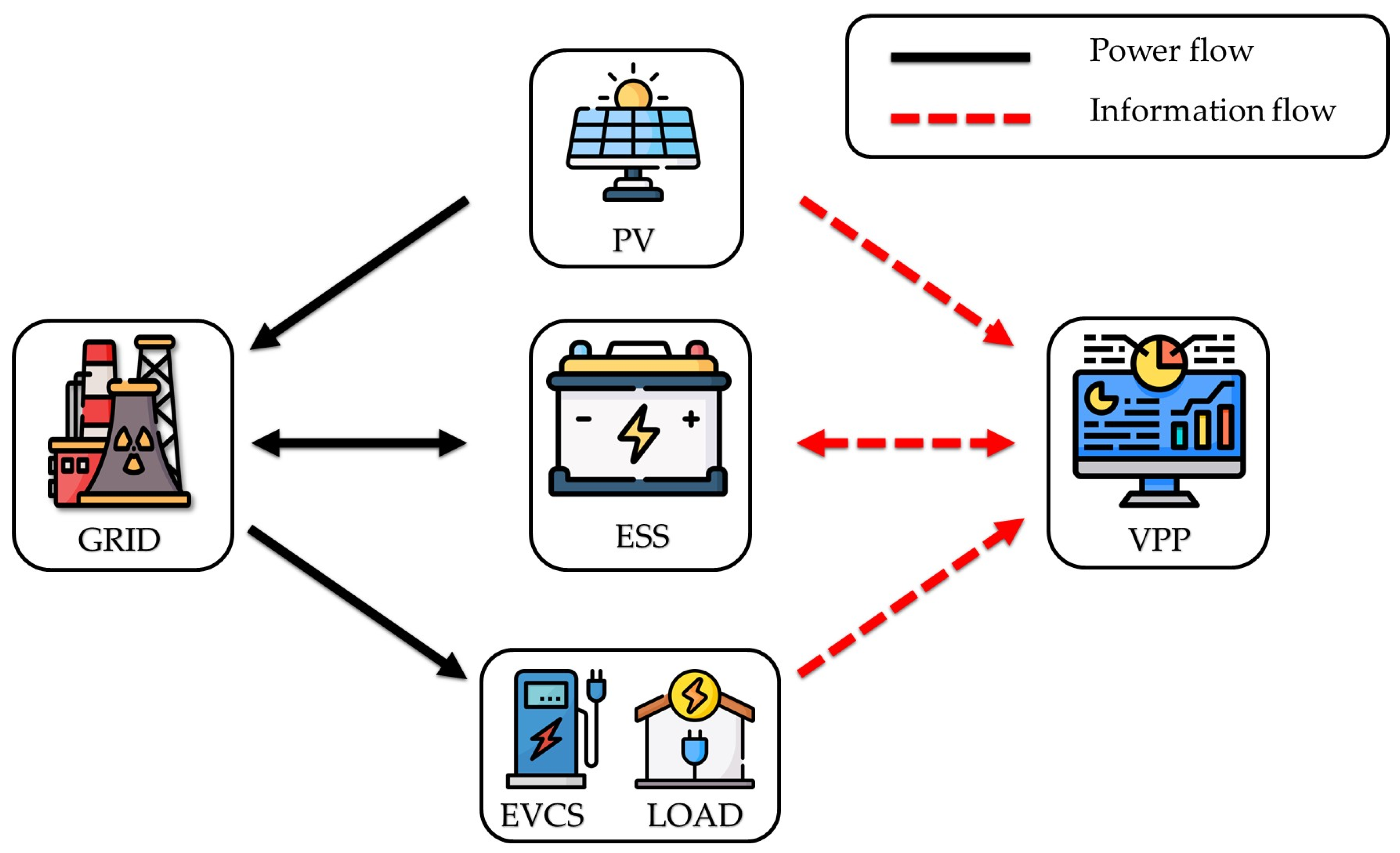

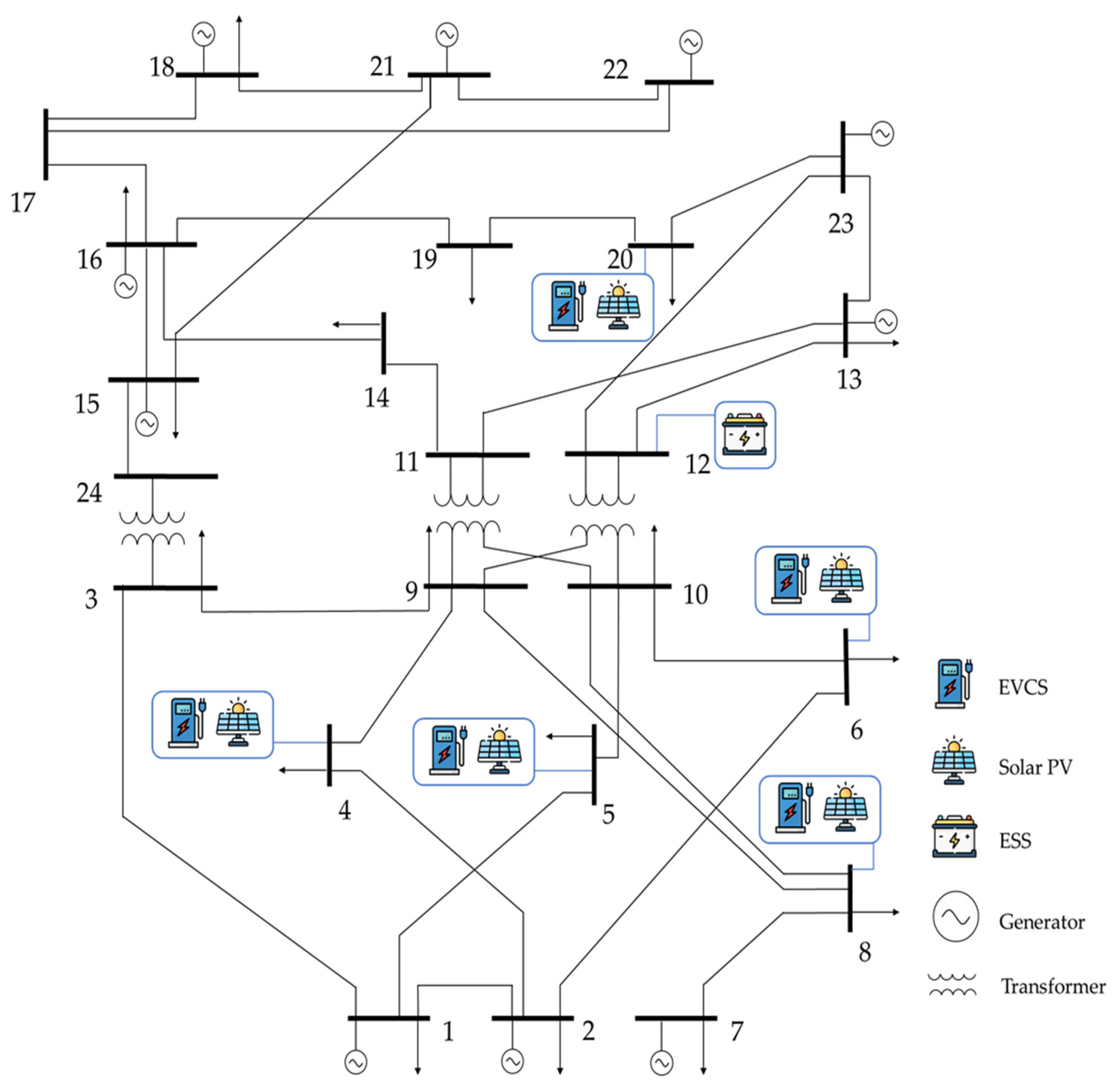
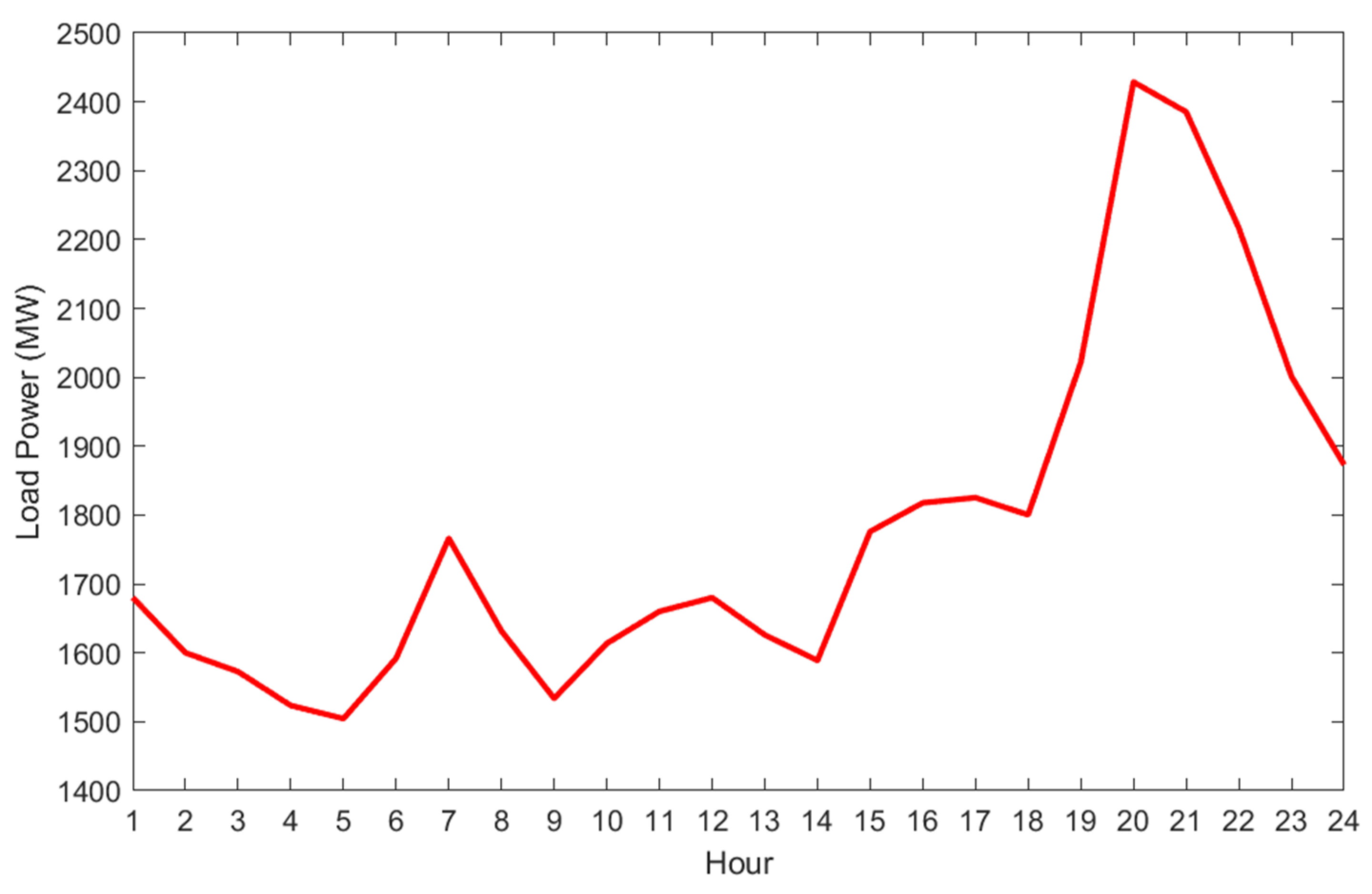
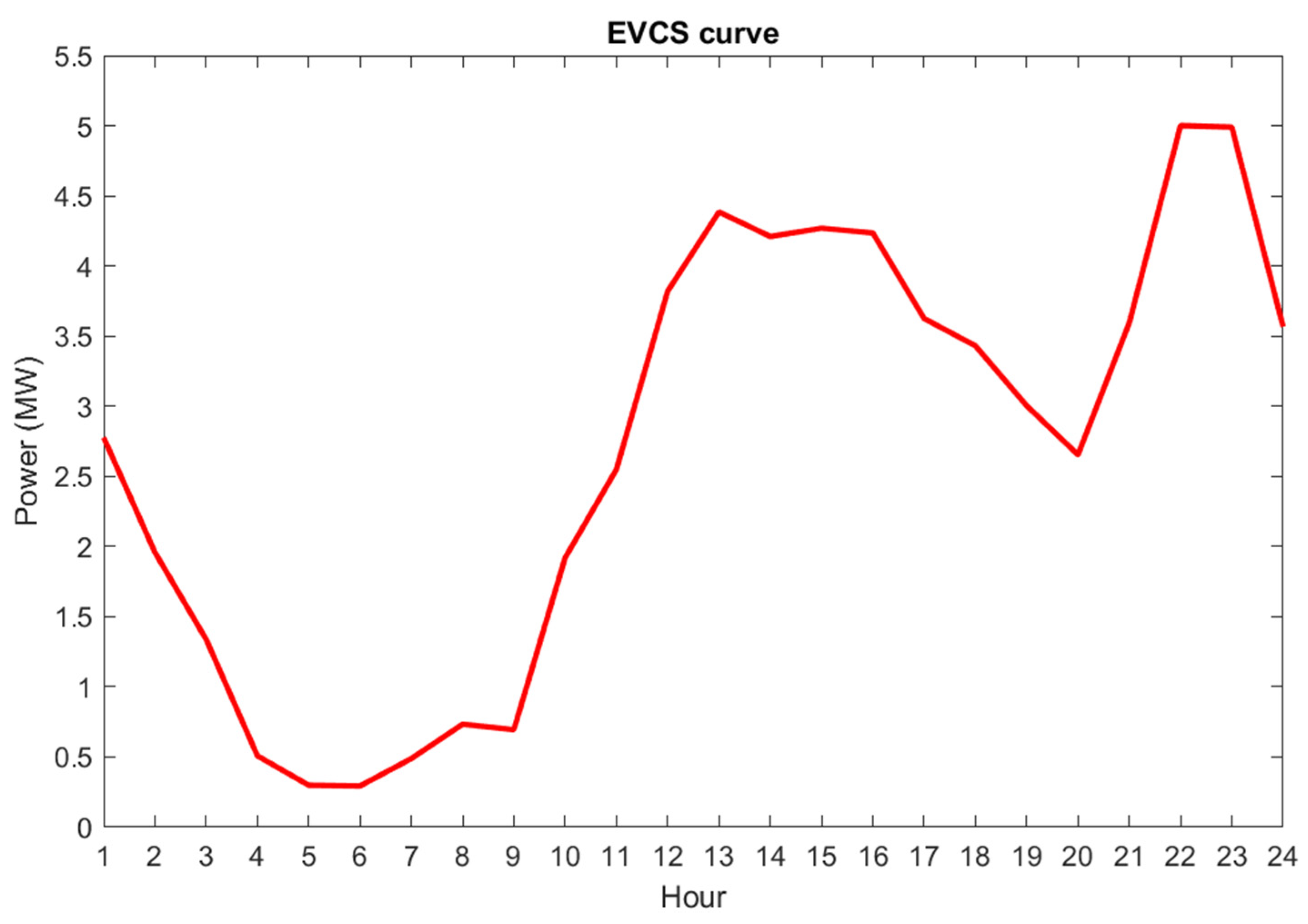
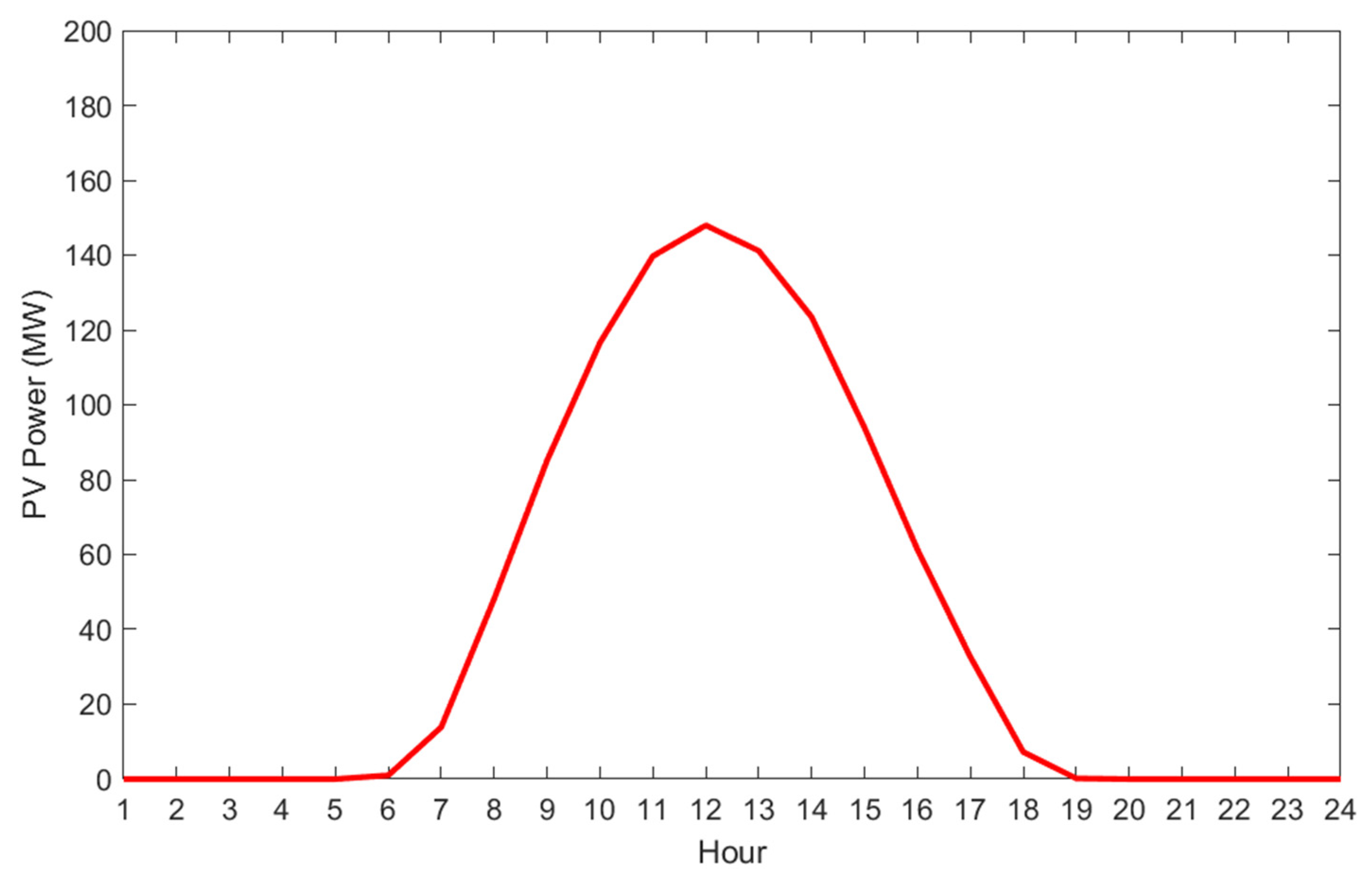
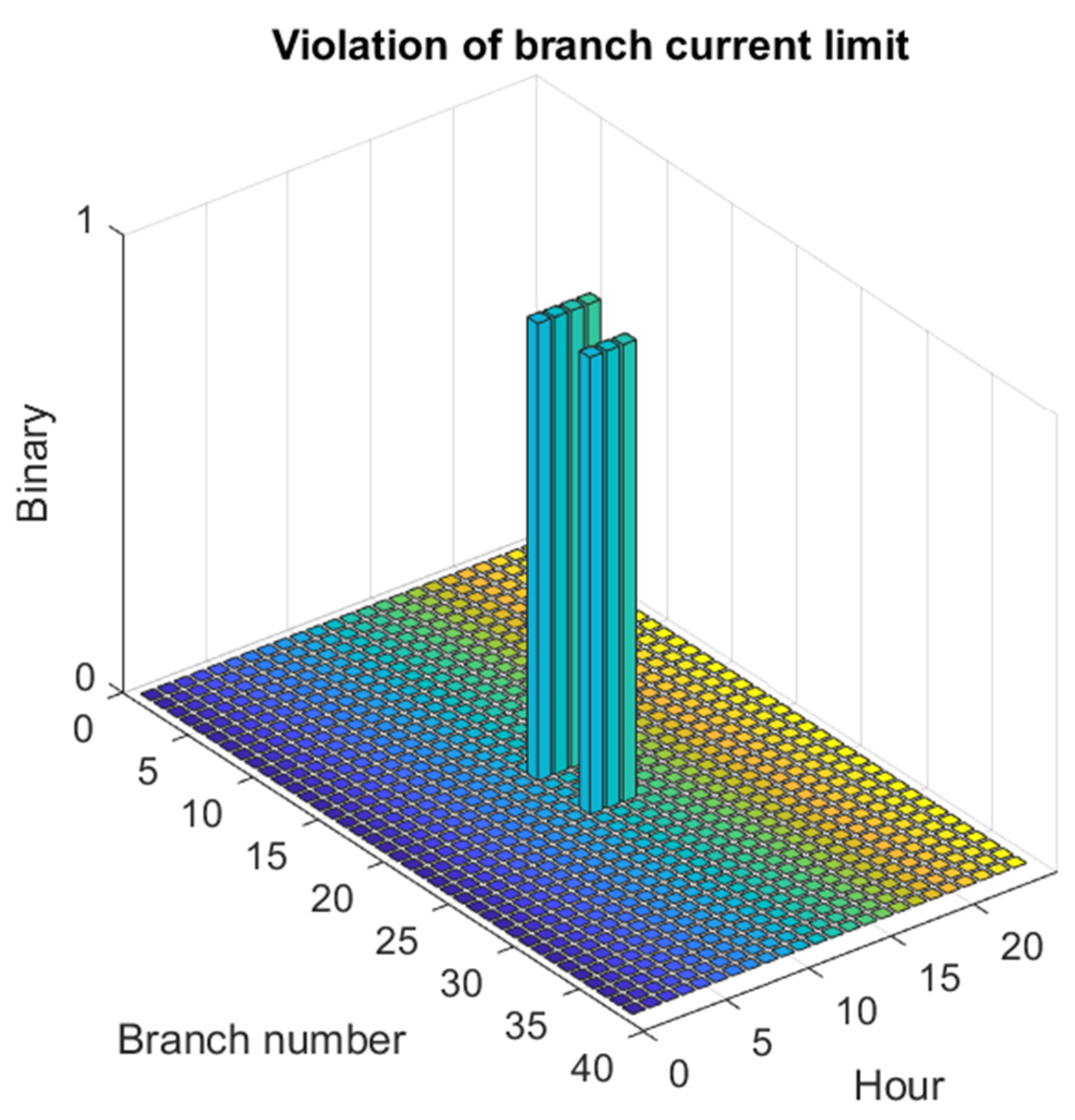
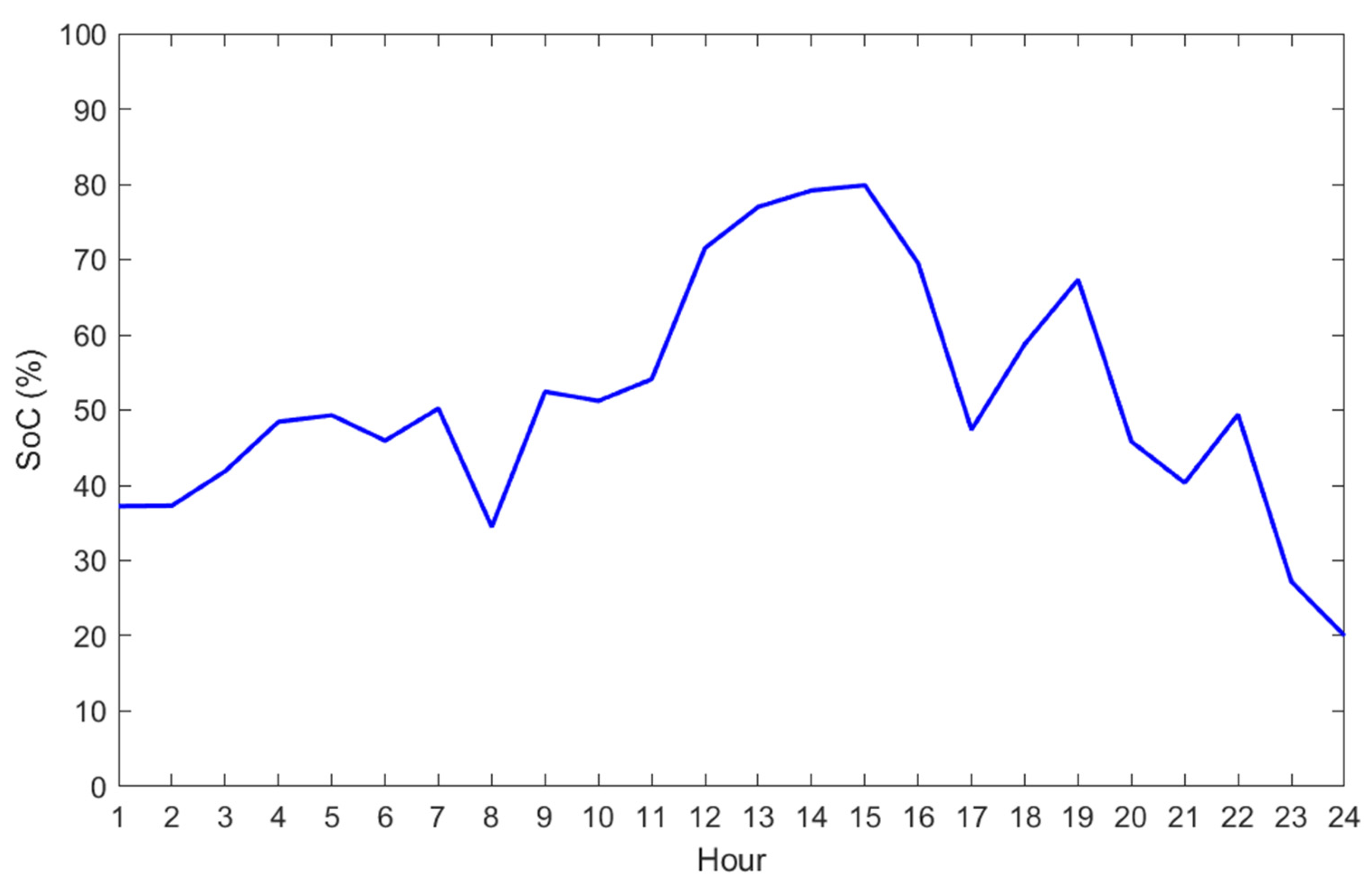

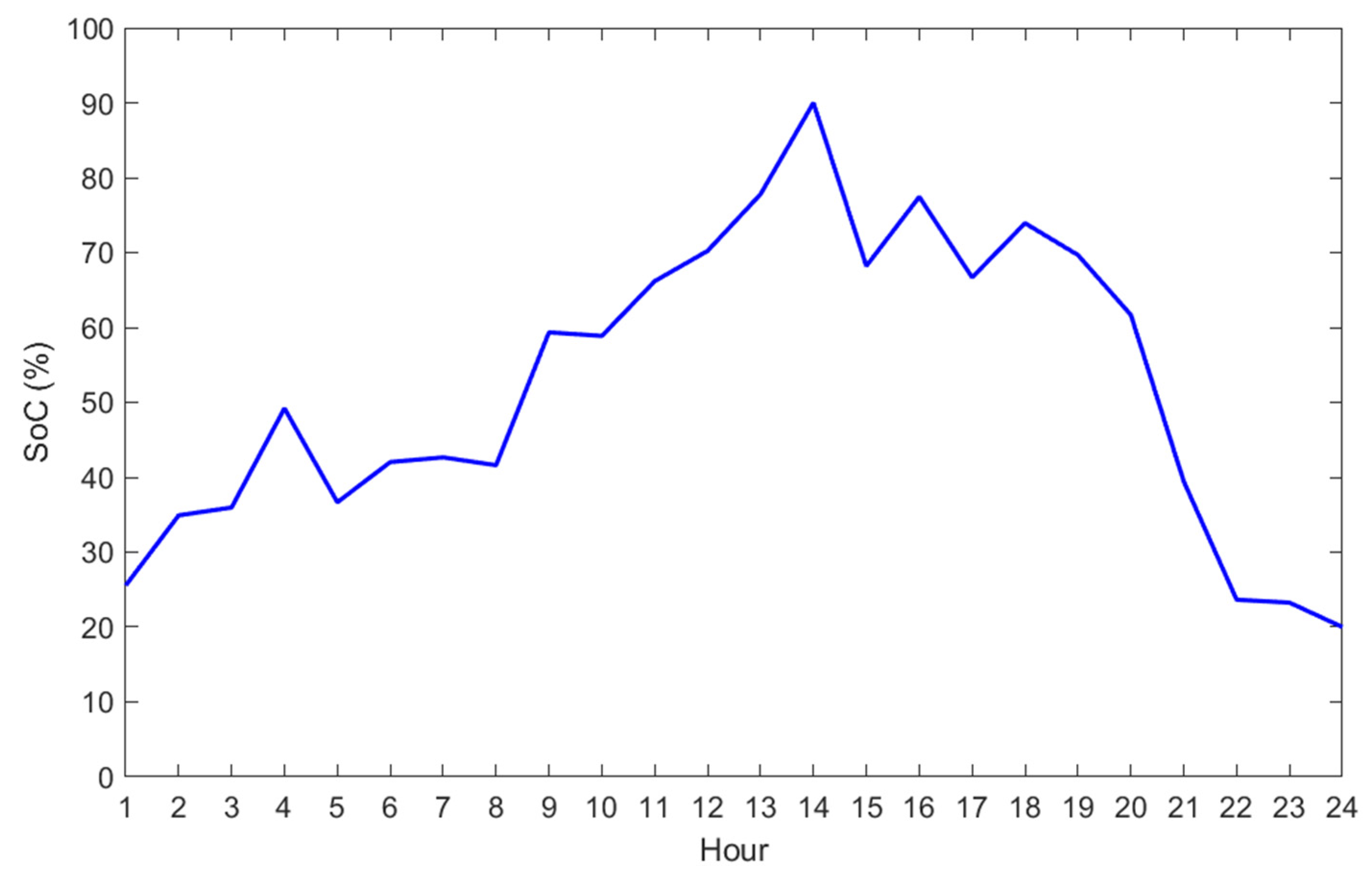

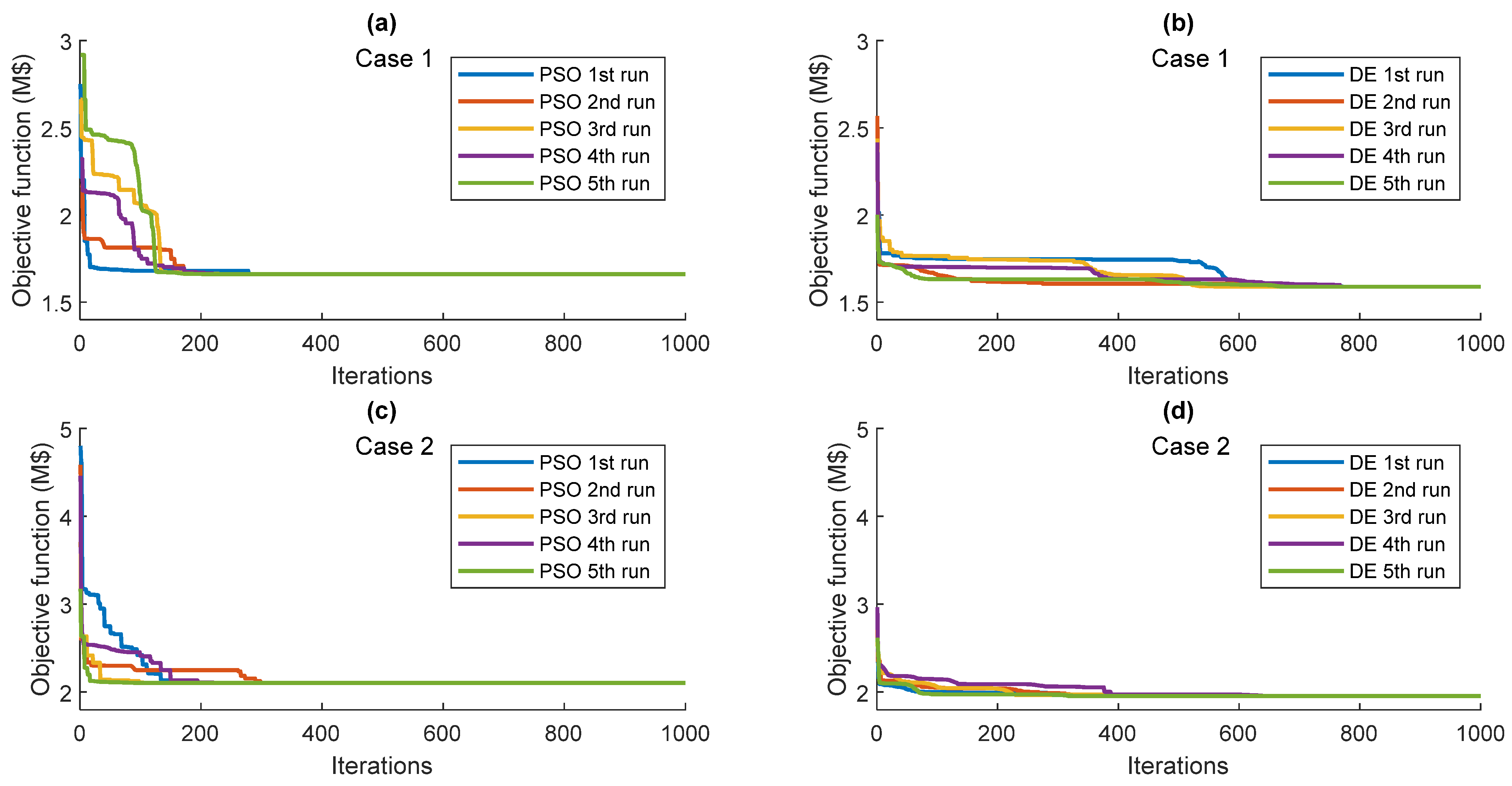
| Parameters | Value |
|---|---|
| ($/kWh) | 300 |
| (MW) | 300 |
| (MW) | 300 |
| (MW) | −300 |
| (MWh) | 1500 |
| (%) | 20 |
| (%) | 90 |
| 0.9 | |
| 0.9 |
| Parameter | Value |
|---|---|
| Number of populations () | 30 |
| Crossover factor () | 0.9 |
| Scaling factor (F) | 0.6 |
| Parameter | Value |
|---|---|
| Number of populations | 30 |
| Inertia factor (W) | 0.9 |
| Learning factors (C1, C2) | 2 |
| Type and Fuel of Generator | Size of Generator (MW) | Capital Cost ($/kW) | Lifetime (Year) |
|---|---|---|---|
| Fossil Steam (Oil) | 12 | 1300 | 35 |
| 20 | |||
| 100 | |||
| 197 | |||
| Fossil Steam (Coal) | 76 | 1800 | |
| 155 | |||
| 350 | |||
| Hydro (Water) | 50 | 1050 | |
| Nuclear Steam (Light water reactor) | 400 | 1200 |
| Algorithm | Case | Operation Cost ($) | Battery Degradation Cost ($) | Generator Degradation Cost ($) |
|---|---|---|---|---|
| PSO | 1 | 1,018,746.76 | 642,785.60 | 546,290.78 |
| 2 | 1,013,803.34 | 666,420.38 | 423,025.62 | |
| Cost difference (%) | 0.49 | 3.68 | 22.56 | |
| DE | 1 | 1,011,966.58 | 551,913.68 | 540,176.40 |
| 2 | 1,008,166.89 | 589,975.19 | 357,317.11 | |
| Cost difference (%) | 0.38 | 6.90 | 33.85 | |
| Case | The Total Cost of Objective Function ($) | Cost Difference (%) | |
|---|---|---|---|
| PSO | DE | ||
| 1 | 2,207,823.13 | 2,104,056.65 | 4.70 |
| 2 | 2,103,249.33 | 1,955,459.19 | 7.03 |
| Cost difference (%) | 4.74 | 7.06 | - |
Disclaimer/Publisher’s Note: The statements, opinions and data contained in all publications are solely those of the individual author(s) and contributor(s) and not of MDPI and/or the editor(s). MDPI and/or the editor(s) disclaim responsibility for any injury to people or property resulting from any ideas, methods, instructions or products referred to in the content. |
© 2023 by the authors. Licensee MDPI, Basel, Switzerland. This article is an open access article distributed under the terms and conditions of the Creative Commons Attribution (CC BY) license (https://creativecommons.org/licenses/by/4.0/).
Share and Cite
Borisoot, K.; Liemthong, R.; Srithapon, C.; Chatthaworn, R. Optimal Energy Management for Virtual Power Plant Considering Operation and Degradation Costs of Energy Storage System and Generators. Energies 2023, 16, 2862. https://doi.org/10.3390/en16062862
Borisoot K, Liemthong R, Srithapon C, Chatthaworn R. Optimal Energy Management for Virtual Power Plant Considering Operation and Degradation Costs of Energy Storage System and Generators. Energies. 2023; 16(6):2862. https://doi.org/10.3390/en16062862
Chicago/Turabian StyleBorisoot, Kanjanapon, Rittichai Liemthong, Chitchai Srithapon, and Rongrit Chatthaworn. 2023. "Optimal Energy Management for Virtual Power Plant Considering Operation and Degradation Costs of Energy Storage System and Generators" Energies 16, no. 6: 2862. https://doi.org/10.3390/en16062862
APA StyleBorisoot, K., Liemthong, R., Srithapon, C., & Chatthaworn, R. (2023). Optimal Energy Management for Virtual Power Plant Considering Operation and Degradation Costs of Energy Storage System and Generators. Energies, 16(6), 2862. https://doi.org/10.3390/en16062862







